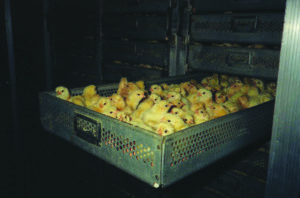Chickens confined to the farming industry can be grouped into egg-laying hens and chickens reared for meat (known in the industry as ‘broilers’). These are two different breeds of chickens, yet both suffer equally. In the UK alone, more than 1 billion chickens are killed every year, making modern poultry farming one of the most exploitative agricultural systems in the world.
In the wild, these charming animals would spend their days dustbathing and foraging among rich undergrowth, living in groups of familiar individuals and family members. We believe that vision is possible, but first we must confront the reality.
Farming chickens for meat
Farming chickens for meat begins with hatching eggs inside industrial incubators and then transferring the chicks to giant barns known as ‘broiler sheds’ which house up to 50,000 birds at a time. Such huge numbers of birds can be incredibly stressful, especially when combined with the noise of automated feeding machines and cooling systems, high temperatures and increasingly dirty conditions (these sheds are only cleaned once birds have left for slaughter, at around 6 weeks of age, ready for the next flock of newly hatched chicks to arrive).
In the UK, 95% of chickens killed for meat are intensively farmed and will spend the entirety of their lives inside these sheds.

Selectively bred to grow unnaturally fast, the chickens quickly fill the available space in the shed with as little as 526cm2 per bird – less than an A4 sheet of paper and more crowded than the now-banned battery cages for egg-laying hens. Since 1950, typical growth rates have increased 400% putting enormous strain on their skeleton and organs. Leg deformities are common, as birds cannot carry their own weight, and many also suffer from ascites, a condition where the heart and lungs cannot supply the body with enough oxygen.
The crowded sheds are a hotspot for dirty conditions. As the litter becomes increasingly saturated with waste, ammonia is released which can burn chickens’ legs (known as ‘hock burn’). One investigation found visible evidence of hock burn on a third of UK supermarket chicken. The industry try to reduce the risk of infectious diseases by lacing the chickens’ food with antibiotics. Despite this, more than 80 million individuals died prematurely in 2022, before reaching the ‘appropriate’ weight for slaughter. This is a mortality rate of nearly 7% which is 2% more than what the industry considers acceptable and inevitable.
Chickens reared for meat will be sent to slaughter at just 6 weeks old, a fraction of their natural lifespan which is around 6 years.
When the time comes, workers will catch the birds by their legs and cram them into crates, while forklifts drive back and forth through the sheds carrying full crates to the awaiting lorries. This is an incredibly stressful experience for the birds, who have never known life outside these sheds and have certainly never been exposed to the noise and commotion of heavy-duty machinery like forklifts.
Government guidelines stipulate that birds should not be deprived of sustenance before transport, but feed and water lines are often raised to allow workers and forklift drivers better access to the sheds. Transport guidelines for broiler chickens are incredibly vague: for example, animals should be unloaded at the slaughterhouse “as soon as possible” but no maximum times are given.
There are two methods of slaughtering chickens destined for supermarket shelves – gassing or by electrical stunning followed by cutting their throat. By far the most common method is gassing, accounting for around 80% of poultry slaughters. Birds remain in the crates in which they were transported, which are then placed into a chamber where they are exposed to a mixture of air and gas until dead. Birds have been shown to find this method distressing, gasping for air and shaking their heads.
The alternative method involves shackling the birds by their feet to a conveyor belt, which moves them through an electrified water bath (intended to stun them) followed by a mechanical blade which cuts their neck. However, some birds in their panic will lift their heads away from the water baths and are not stunned, while the mechanical blade can sometimes miss birds entirely. If birds are missed entirely, they enter scalding hot water tanks (designed to loosen their feathers ready for the next stage) essentially boiling them alive.
In commercial slaughterhouses with high outputs, several thousand birds can go through this process in a single hour.

Take action for chickens
Killing an animal can never be considered humane because animals' lives are as important to them as ours are to us. Take action today for a kinder tomorrow.

